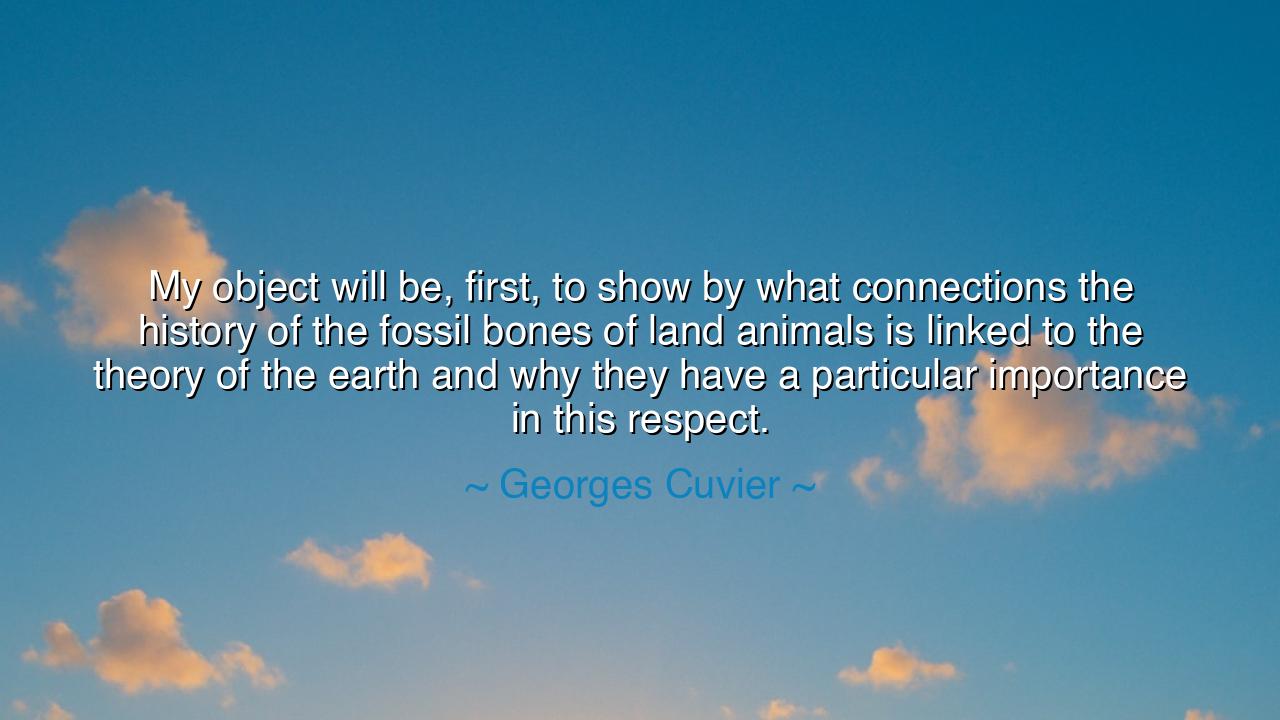
My object will be, first, to show by what connections the history
My object will be, first, to show by what connections the history of the fossil bones of land animals is linked to the theory of the earth and why they have a particular importance in this respect.






Hear, O seekers of wisdom, the words of Georges Cuvier, father of paleontology, who declared: “My object will be, first, to show by what connections the history of the fossil bones of land animals is linked to the theory of the earth and why they have a particular importance in this respect.” In this utterance, we perceive not only the curiosity of a man of science, but the fire of one who sought to bind the fragments of the past into a grand vision of truth. For in the broken bones of ancient creatures he saw not relics alone, but keys to the great story of the earth itself.
The meaning of this declaration is vast. Cuvier tells us that to study the remains of animals long dead is not to indulge in idle speculation, but to glimpse the very processes by which the world was formed and shaped. The fossil bones are more than curiosities; they are the sacred testimony of time, written in stone. Each fragment, each fossilized tooth or rib, is a letter in the grand chronicle of nature, and when assembled with care, they speak of floods, extinctions, and rebirths. Thus, Cuvier’s purpose was not small: he sought to unite the history of life with the very theory of the earth, to show how creatures and landscapes are woven into one fabric.
The origin of his thought lies in a time when men debated fiercely whether the earth was ancient or young, whether the creatures buried beneath its surface were remnants of catastrophe or idle tricks of stone. Cuvier, with steady hands and a mind of discipline, brought forth order from confusion. By studying the remains of mammoths, mastodons, and giant sloths, he revealed that entire species had vanished from the earth, never to return. This idea—extinction—was shocking, for many had believed that no part of creation could be lost. Yet Cuvier stood firm, declaring that the bones bore witness to truths that could not be denied.
Consider the story of his discovery of the Mastodon. In the hills of America, bones were unearthed of creatures larger than elephants, yet unlike any living beast. Many thought them the remains of giants spoken of in legend. But Cuvier, with his keen eye, recognized them as belonging to a species no longer living upon the earth. Here was proof that time does not merely preserve, but also destroys—that the world has known not one creation, but many ages. His insight forever changed how mankind viewed its place in the cosmos.
The emotional strength of Cuvier’s words lies in their grandeur: he reminds us that the smallest fragment can reveal the largest truths. A fossil bone, buried in silence for millennia, can shatter our ignorance and humble our pride. From such bones, he reconstructed entire worlds—jungles that no longer exist, beasts that no longer roam, climates long vanished. And in so doing, he awakened humanity to the vastness of time, to the cycles of destruction and renewal that shape our destiny.
The lesson here is profound: we must respect the evidence of the past, for it teaches us about the present and warns us of the future. Just as Cuvier read in the bones the record of vanished worlds, so must we read in the patterns of nature the warnings of our own age. The earth speaks through its stones, its seas, its skies, and if we close our ears, we shall be as blind as those who mocked extinction before Cuvier revealed it.
Therefore, let your actions be guided by this wisdom. Seek truth not only in the grand, but in the small. Pay heed to the fragments of history, the lessons of ancestors, the warnings of nature. Do not dismiss the humble bone or the quiet voice, for within them may lie revelations that change the course of knowledge. Study, observe, and respect the evidence of creation, for in it lies the key to wisdom.
And so, remember the teaching of Cuvier: the bones of the earth are not dead things, but the living testimony of time. To honor them is to honor truth itself. To ignore them is to walk blindly through a world filled with signs. May you, like him, learn to see connections where others see only fragments, and to draw from the dust of ages a vision of eternity.






AAdministratorAdministrator
Welcome, honored guests. Please leave a comment, we will respond soon